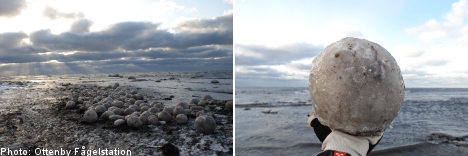Bird watchers stumbled an unusual natural phenomenon when they stumbled across dozens of football-sized balls of ice lying on the shore on the Baltic island of Öland off Sweden’s southeastern coast.
A week before Christmas 2009, Magnus Bladh of the Ottenby bird station, located on Öland’s southern cape, was strolling along the beach with a colleague when he saw something he’d never seen before: About 200 large ice balls, which varied in size but with the larger ones growing bigger than a football. What mystified Bladh was that the balls were resting on the west side of a bed of seaweed, even though the prevailing winds were from the east.
How do these odd ice balls form?
They discovered ice balls consisted of a 2 to 5 centimeter thick shell of ice, which covered a core of soft, wet snow. These ice balls likely form when rolls of light snow are blown from the shore into water which is at or just below freezing, but fails to form uniform ice due to strong winds. The rolls of snow are then tossed about in the chilly waters, where wave action eventually shapes them into balls of ice. Here a video example of ice balls that formed on Lake Michigan in February 2013:
Weather conditions on southern Öland in the days leading up to Bladh’s ice ball discovery revealed that temperatures in the area were generally below freezing, with snowfall, and winds from the north and northeast averaging 50 kilometers per hour. So it is reasonable to believe that rolls of snow near the shore remained soft due to warmth emanating up from the ground, which could have then been blown into the water by the strong winds. Once formed, the balls likely came back to shore and, rather than floating out to open water, remained there due to a change in sea conditions in the days before the ice balls were discovered.
Besides this discovery, only two other reported instances of ice balls have been discovered in Sweden since the 1950s. [Source]













[…] know snow can form strange balls. But this folded snow pictured in these photographs below is for me a mystery which has occurred in […]
[…] Mysterious Natural Phenomenon: Giant Ice Balls Found On A Sweden’s Beach […]